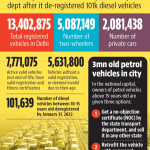Upgrade Now To Euro 4 Certified Petrol Vehicles For Maximum Performance!
Petrol Vehicles Minimum Euro 4: A Step Towards Cleaner and Greener Transportation
Introduction
Dear Readers,
1 Picture Gallery: Upgrade Now To Euro 4 Certified Petrol Vehicles For Maximum Performance!

Welcome to our article on petrol vehicles minimum Euro 4, where we will explore the importance and benefits of adopting this standard in the automotive industry. In recent years, there has been a growing concern about the environmental impact of petrol vehicles and the need to reduce harmful emissions. The Euro 4 emission standard is a significant step forward in addressing these concerns and promoting cleaner and greener transportation.

Image Source: wikimedia.org
In this article, we will provide you with a comprehensive overview of petrol vehicles minimum Euro 4, including what it is, who it affects, when it was introduced, where it is implemented, why it is crucial, and how it contributes to a sustainable future. So, let’s dive in and learn more about this important topic!
What is Petrol Vehicles Minimum Euro 4?
Euro 4 is an emission standard that sets limits on the amount of pollutants emitted by vehicles powered by petrol. It was introduced in Europe in 2005 as part of the European emission standards for vehicles. The objective of Euro 4 is to reduce harmful emissions such as nitrogen oxides (NOx), carbon monoxide (CO), hydrocarbons (HC), and particulate matter (PM) from petrol vehicles.
Limitations of Euro 4
Despite its effectiveness in reducing emissions, Euro 4 has its limitations. These include:
Image Source: twimg.com
1. Euro 4 focuses primarily on petrol vehicles and does not address emissions from diesel vehicles.
2. It does not consider the emission levels during the start-up phase, which can be higher than during normal operation.
3. Euro 4 does not regulate emissions from older vehicles that were manufactured before its implementation.
4. The emission limits set by Euro 4 may still not be sufficient to meet the long-term sustainability goals.
Who does Petrol Vehicles Minimum Euro 4 Affect?
Petrol vehicles minimum Euro 4 affects various stakeholders within the automotive industry, including:
1. Vehicle Manufacturers: Manufacturers need to ensure that their new petrol vehicles comply with the Euro 4 emission standards to be approved for sale in the European market.
2. Consumers: Consumers who want to buy new petrol vehicles have the assurance that these vehicles meet the minimum emission standards, resulting in reduced environmental impact.
3. Governments and Regulatory Bodies: Governments and regulatory bodies play a crucial role in enforcing the Euro 4 standards and monitoring compliance to ensure a cleaner and healthier environment.
4. Environmental Organizations: Environmental organizations advocate for stricter emission standards and promote the use of cleaner and more sustainable transportation options.
When was Petrol Vehicles Minimum Euro 4 Introduced?
The Euro 4 emission standard for petrol vehicles was introduced in Europe on January 1, 2005. It was a significant milestone in the European Union’s commitment to reducing air pollution and improving air quality in urban areas.
Where is Petrol Vehicles Minimum Euro 4 Implemented?
Petrol vehicles minimum Euro 4 is implemented across all European Union member states. It is also adopted by several other countries around the world, including those in Southeast Asia and South America.
Why is Petrol Vehicles Minimum Euro 4 Crucial?
Petrol vehicles minimum Euro 4 is crucial for several reasons:
1. Environmental Impact: By reducing emissions, Euro 4 contributes to improving air quality and minimizing the negative impact of petrol vehicles on the environment.
2. Health Benefits: Lower emissions mean reduced exposure to harmful pollutants, leading to improved public health and a decrease in respiratory diseases.
3. Climate Change Mitigation: Euro 4 helps to reduce greenhouse gas emissions, which are responsible for climate change and its associated impacts.
4. International Commitments: The adoption of Euro 4 aligns with international agreements and commitments, such as the Paris Agreement, which aims to limit global warming.
How does Petrol Vehicles Minimum Euro 4 Contribute to a Sustainable Future?
Petrol vehicles minimum Euro 4 contributes to a sustainable future in the following ways:
1. Transition to Cleaner Transportation: By setting emission standards, Euro 4 encourages the development and adoption of cleaner and more sustainable transportation technologies.
2. Innovation and Research: The implementation of Euro 4 prompts manufacturers to invest in research and development of advanced technologies to meet the emission requirements.
3. Public Awareness and Education: Euro 4 raises awareness among consumers about the importance of reducing emissions and promotes the use of greener transportation options.
4. Collaboration and Cooperation: The adoption of Euro 4 fosters international cooperation in addressing environmental challenges and working towards a common goal of sustainability.
Advantages and Disadvantages of Petrol Vehicles Minimum Euro 4
Advantages
1. Reduced Environmental Impact: Euro 4-compliant petrol vehicles emit fewer pollutants, leading to improved air quality and reduced environmental damage.
2. Improved Public Health: Lower emissions contribute to better respiratory health and a decrease in air pollution-related diseases.
3. Global Compatibility: The Euro 4 standards are compatible with international emission standards, facilitating trade and reducing barriers for vehicle manufacturers.
4. Encouragement of Technological Advancements: To meet the emission requirements, manufacturers invest in research and development of cleaner and more efficient technologies.
5. Support for Sustainable Development Goals: Euro 4 aligns with the United Nations’ Sustainable Development Goals, particularly those related to climate action, clean air, and sustainable cities.
Disadvantages
1. Limitation to Petrol Vehicles: Euro 4 only addresses emissions from petrol vehicles and does not regulate emissions from diesel vehicles, which can still contribute significantly to air pollution.
2. Exclusion of Older Vehicles: Euro 4 does not cover vehicles manufactured before its implementation, allowing older, more polluting vehicles to remain on the roads.
3. Insufficient Emission Limits: While Euro 4 sets stricter emission limits, there is still a need for more ambitious targets to achieve long-term sustainability goals.
4. Cost Implications: Manufacturers may incur additional costs in developing and producing Euro 4-compliant vehicles, which could be passed on to consumers.
5. Enforcement Challenges: Ensuring compliance with Euro 4 standards requires effective enforcement mechanisms, which can be challenging for some countries.
Frequently Asked Questions (FAQs)
Q1: Does Euro 4 apply to all petrol vehicles?
A1: Yes, Euro 4 applies to all newly manufactured petrol vehicles sold in European Union member states and several other countries.
Q2: Are older petrol vehicles affected by Euro 4?
A2: No, Euro 4 does not apply retroactively to older vehicles. It only sets emission standards for newly manufactured vehicles.
Q3: What are the penalties for non-compliance with Euro 4 standards?
A3: Penalties for non-compliance vary by country and can include fines, vehicle impoundment, and restrictions on vehicle registration or sales.
Q4: Are there any exemptions to Euro 4 requirements?
A4: Certain categories of vehicles, such as emergency service vehicles and historic vehicles, may be exempted from Euro 4 requirements based on specific regulations in each country.
Q5: What is the future of emission standards beyond Euro 4?
A5: Emission standards are continually evolving to address emerging environmental challenges. Euro 5 and Euro 6 are the subsequent standards that build upon the achievements of Euro 4.
Conclusion: Taking Action for a Cleaner Future
Friends, the implementation of petrol vehicles minimum Euro 4 is a significant step towards cleaner and greener transportation. By reducing emissions from petrol vehicles, we can improve air quality, protect public health, and mitigate climate change. As consumers, let’s choose Euro 4-compliant vehicles, support sustainable transportation initiatives, and advocate for stricter emission standards. Together, we can create a cleaner and more sustainable future for ourselves and future generations.
Final Remarks
Disclaimer: The information provided in this article is for educational and informational purposes only. We do not endorse any specific products or manufacturers mentioned. The accuracy and completeness of the information presented may vary over time due to changing regulations and advancements in technology. Please consult official sources and experts for the latest information on petrol vehicles minimum Euro 4 and related topics.
This post topic: Fuel Efficiency Tips



